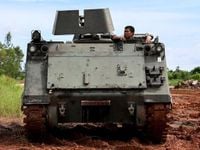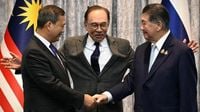On July 28, 2025, Thailand and Cambodia agreed to an "immediate and unconditional" ceasefire after five days of intense and deadly fighting along their disputed 800-kilometer border. The truce, brokered in Malaysia by Malaysian Prime Minister Anwar Ibrahim and with significant involvement from U.S. President Donald Trump and Chinese President Xi Jinping, was hailed as a vital first step toward de-escalation and restoring peace in the region.
The conflict, which reignited longstanding tensions between the two Southeast Asian neighbors, had killed at least 43 people—many of them civilians—and displaced more than 300,000 residents on both sides. The fighting began on July 24, 2025, following a landmine explosion that wounded five Thai soldiers, and escalated rapidly with artillery, rocket fire, and even airstrikes. The violence marked the deadliest border flare-up since clashes that occurred between 2008 and 2011.
Prime Ministers Hun Manet of Cambodia and acting Thai Prime Minister Phumtham Wechayachai met in Putrajaya, Malaysia, on Monday to formally agree to the ceasefire. Flanked by Anwar Ibrahim, the leaders shook hands before the agreement took effect at midnight. Anwar called the ceasefire a "vital first step towards a de-escalation and the restoration of peace and security." The ceasefire was the culmination of intense diplomatic efforts, with Trump reportedly leveraging trade relations to push the parties toward peace.
Despite the hopeful start, cracks quickly appeared. On the morning of July 29, Thailand’s military accused Cambodian forces of violating the ceasefire by launching attacks in multiple areas along the border. Major General Winthai Suvaree, spokesman for the Thai army, stated that these actions constituted a "deliberate violation of the agreement and a clear attempt to undermine mutual trust." He added that Thai troops responded "appropriately" and in "self-defense." The Thai government also lodged complaints with Malaysia, the U.S., and China regarding Cambodia's alleged breaches.
Meanwhile, Cambodia firmly denied the accusations. Maly Socheata, spokesperson for Cambodia’s Ministry of National Defense, asserted that the Royal Cambodian Armed Forces had "strictly adhered to the orders and agreements under the ceasefire." Cambodian Defense Minister Tea Seiha emphasized that Cambodia's army abided by the truce and that defense officials would lead a delegation of diplomats and military attachés to observe the situation along the border.
Acting Thai Prime Minister Phumtham acknowledged that some "undisciplined soldiers" might have been involved in isolated incidents but stressed that Thai forces responded proportionately: "If they shoot at us with small firearms, we’ll respond with small firearms." He downplayed escalation risks, stating, "At the moment, it is considered calm." Phumtham also revealed that the Thai civilian government consulted closely with the military on ceasefire negotiations, highlighting the army’s central role in decision-making.
In a series of meetings on July 29, military commanders from both sides convened to discuss implementation of the ceasefire. They agreed to halt troop movements, avoid further escalation, and establish coordination teams to resolve any disputes. Lim Menghour, Director General of Cambodia’s National Assembly, called the agreement to refrain from deploying additional troops "the key development." These talks, held in the Cambodian border town of O Smach and other locations, fostered a positive atmosphere and were considered a crucial test of the ceasefire’s durability.
A joint border committee meeting is scheduled for August 4, 2025, in Cambodia, where defense ministers and senior military commanders from both countries will convene, with Malaysia acting as an observer. This meeting aims to further ease tensions and solidify the truce.
Along the border, signs of calm emerged. In Cambodia’s Samraong city, an AFP journalist reported that the sound of blasts ceased 30 minutes before midnight on July 28 and remained quiet through dawn. Cambodian Prime Minister Hun Manet posted on Facebook that "The front line has eased since the ceasefire at 12 midnight." Residents in Oddar Meanchey province similarly reported no exchange of fire overnight or in the morning. In Thailand’s Surin province, village chief Kritsada Jindasri noted heavy firing Monday night but observed silence at midnight, though he and others remained cautious about the ceasefire’s longevity.
Despite the ceasefire, the conflict has inflicted significant damage. Thailand estimates the economic impact at over 10 billion baht (approximately $300 million) and is preparing a budget of at least 25 billion baht to mitigate effects, including relief measures such as soft loans, loan repayment deferrals, and tax breaks. Some border areas have begun to resume daily activity, with residents cautiously returning home.
The conflict’s roots trace back decades, with territorial disputes flaring repeatedly. A notable flashpoint occurred in 2008 when Cambodia attempted to register an 11th-century temple in the disputed area as a UNESCO World Heritage Site, provoking protests in Thailand. Tensions escalated in May 2025 after a Cambodian soldier was killed in a border skirmish, followed by renewed clashes in June and July.
The recent fighting also triggered diplomatic fallout, including Thailand closing some border crossings, expelling the Cambodian ambassador, and recalling its own. Cambodia responded by banning Thai imports such as fruits and vegetables and halting power and internet services. Both countries increased their military presence along the border in the weeks leading up to the conflict.
Observers emphasize the fragility of the ceasefire. Political scientist Thitinan Pongsudhirak of Chulalongkorn University noted that "third-party monitoring is essential to keep [the ceasefire] in place," given the deep-seated hostilities. Cambodian researcher Kokthay Eng credited President Trump’s "trade leverage and strongman mentality" with helping to save lives but warned that the truce may falter if the Thai government fails to secure lower U.S. tariffs.
U.S. Secretary of State Marco Rubio praised the ceasefire and urged both nations to honor their commitments. Following the agreement, President Trump pledged U.S. participation in monitoring efforts alongside Malaysia and indicated that trade negotiations with Thailand could proceed, with hopes of favorable terms. The U.S. is set to announce new trade tariff decisions soon, with a 36% tariff on Thai and Cambodian goods scheduled to take effect on August 1, 2025, pending successful negotiations.
For many along the border, the ceasefire offers a glimmer of hope amid uncertainty. Soklang Slay, a Cambodian resident who fled heavy fighting in Oddar Meanchay province, expressed concern about renewed violence but welcomed the pause. Thai villagers, too, remain watchful but hopeful as they return to their homes and livelihoods.
While the ceasefire marks a critical step toward peace, the path ahead remains fraught with challenges. The upcoming meetings, coordinated efforts to monitor the truce, and diplomatic engagement will be key to preventing a return to violence and fostering lasting stability between Thailand and Cambodia.



